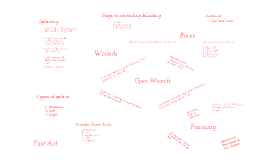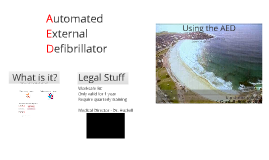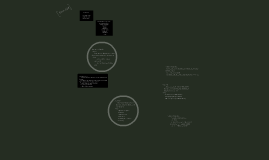First Aid
Transcript: By: Landon Allen First Aid provision of initial care for an illness or injury Prevention Preventing emergencies is the best way to keep your family healthy and safe Cpr emergency procedure which is performed in an effort to return life to a person in cardiac arrest 1. CALL Check the victim for unresponsiveness. If the person is not responsive and not breathing or not breathing normally. Call 911 and return to the victim. In most locations the emergency dispatcher can assist you with CPR instructions. 2. PUMP If the victim is still not breathing normally, coughing or moving, begin chest compressions. Push down in the center of the chest 2 inches 30 times. Pump hard and fast at the rate of at least 100/minute, faster than once per second 3. BLOW Tilt the head back and lift the chin. Pinch nose and cover the mouth with yours and blow until you see the chest rise. Give 2 breaths. Each breath should take 1 second ABC's A. airway- make sure the victims airway isn't blocked. Tilt the victims head back to clear the tongue from obstructing the way. Check the victim for breathing and any objects in their windpipe. B. breathing- when the victim is unresponsive and isn't breathing, then pinch the victim's nose and create a tight seal with the person's mouth and your own. Watch the victim's chest so you don't overinflate. Between each breath allow the victim to exhale. C. circulation/compression- place two fingers between the person's windpipe and the neck muscles and apply pressure. Feel for a pulse. Place two fingers on the sternum located where the lower ribs meet, then put the heel of your hand next to your fingers. Place your other hand on your hand and interlace fingers. Lock your elbows and using your body weight, perform compressions. The depth should be about two inches. Remember "Two Hands" "Two Inches". If you hear ribs cracking or feel it, then you should lessen your compressions. Children Infants Those are the basic for CPR Now let's move on to first aid Basics 1. You should always carry a first aid kit with you. 2. Always be prepared for the worst. First aid kit: Sterile adhesive bandages in assorted sizes, Sterile gauze pads in assorted sizes, Hypoallergenic adhesive tape, Scissors, Tweezers, Needle, Ace bandage, Moistened towelettes, Antiseptic, Thermometer, Tongue blades, Splints in assorted sizes, Petroleum jelly, Assorted sizes of safety pins, Anti-bacterial soap, Antibiotic ointment, Latex gloves and face mask Sunscreen, Aspirin and/or ibuprofen, Ice Pack Bites If you are bitten you may need an immediate shot in case of rabies. Bruises Remember that elders and infants bruise more easily than adults and most children. If the bruise is on the head they may have suffered head trauma. To reduce it: elevate the injured area and apply a commercial ice pack or ice cubes wrapped in a towel for 30 to 45 minutes. Burns 1st degree- have some redness and swelling, cool the burned area with water or Aloe Vera 2nd degree- deeper redness and some blistering, cool the area the same way but take extra care. If blister bursts gently clean it out 3rd degree- Victim may not feel anything, but skin will appear charred and will start to blister and peel instantly. Put out any fires, dial 911 immediately, and don't take off their clothing or it will expose their wounds to the elements. Choking It is usually caused by an object stuck in their windpipe, first ask the victim if they are choking, if they don't respond perform the heimlich maneuver. Cuts and Scrapes Thoroughly clean the wound. Then either bandage it, or if the wound is serious enough you should see a doctor. Electric Shock Most important of all is "DO NOT RUSH TO A VICTIM UNLESS YOU ARE CERTAIN THEY NO LONGER ARE CONDUCTING ELECTRICITY" IF POSSIBLE TURN OFF ELECTRICITY. Call 911, treat all burns, perform CPR if you need. Fractures Typical symptoms are: Immediate and excessive swelling, injured area appears deformed, the farthest point of the injured limb turns blue or is numb to the touch, even slight movement or contact to the injured area causes excessive pain. Dial 911 immediately and immobilize the area with a splint. You can create a splint out of almost anything and just tape it on the damaged area. You should also ICE it. I- ice, C- compression, E- elevate Head injury If the victim experiences excessive bleeding, loss of consciousness, labored breathing, or memory loss call 911 Lay the victim down, stop any bleeding, if needed perform CPR, and don't leave the victim unattended. Nose bleed Although nose bleeds usually aren't usually a dangerous injury they should still be stopped so that no excess blood will be lost. You should apply pressure to the nostrils and keep them pinched shut until the bleeding stops. The victim shouldn't strain themselves for a few hours. Puncture wounds Puncture wounds usually don't have profound bleeding like cuts do and may appear harmless almost, but they carry a greater chance of infection. If you receive a puncture wound

















